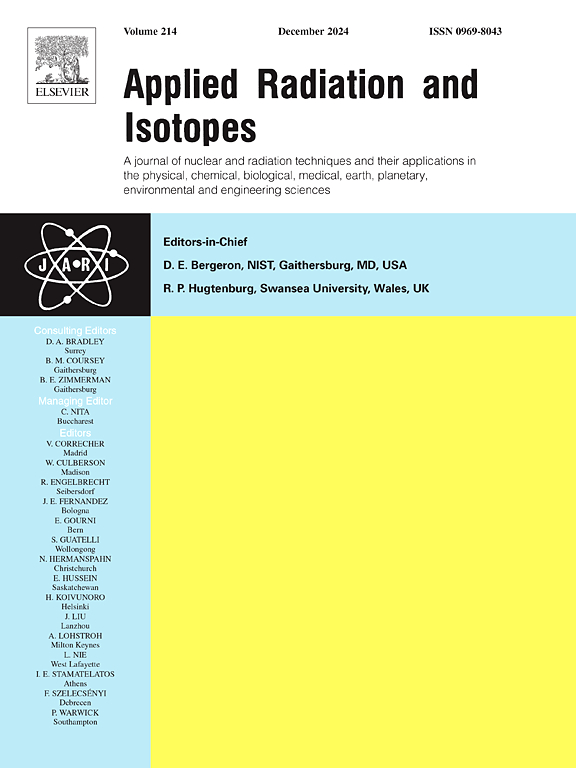Thermoluminescence properties of lithium barium borate glass doped with Vanadium, Samarium and Dysprosium for dosimetry
IF 1.6
3区 工程技术
Q3 CHEMISTRY, INORGANIC & NUCLEAR
引用次数: 0
Abstract
This study investigates the thermoluminescence (TL) properties of lithium barium borate (LBB) glasses doped with Vanadium (V), Samarium (Sm), and Dysprosium (Dy) to evaluate their dosimetric potential under 6 MV photon irradiation at doses ranging from 2 to 10 Gy. The analysis focuses on glow curves, dose-response linearity, and sensitivity in both undoped and doped samples. Dopant concentrations ranging from 0.2 to 1.0 mol% were investigated to determine their impact on TL properties. While undoped LBB exhibits high sensitivity at elevated doses (350 nC/mg at 10 Gy), its variability in linearity (R2 = 0.8627) and sensitivity limits its practical use. Doping at optimized concentrations enhances these properties, refining the glass matrix for improved dosimetric performance. V-doped LBB at 1.0 mol% demonstrates exceptional sensitivity and strong TL responses (87 nC/mg at 10 Gy, R2 = 0.9257), particularly in high-dose applications. Sm-doped LBB at 0.4 mol% provides a well-balanced profile, with improved linearity (R2 = 0.9357) and consistent high TL intensity across all tested doses (119 nC/mg at 10 Gy). Dy-doped LBB at 1.0 mol% exhibits stable and reliable TL performance (105 nC/mg at 10 Gy, R2 = 0.9482) across both low and high doses, ensuring precise and reproducible dosimetry. The results indicate that doping enhances the linear correlation between dose and TL response, refining the dosimetric capabilities of LBB glasses by improving sensitivity, stability, and dose-response consistency. These findings establish doped LBB glasses as promising candidates for accurate and versatile radiation dosimetry applications.
掺钒、钐、镝硼酸锂钡玻璃的热释光特性
本研究调查了掺杂钒(V)、钐(Sm)和镝(Dy)的硼酸锂(LBB)玻璃的热致发光(TL)特性,以评估它们在 6 MV 光子辐照下的剂量潜力,剂量范围为 2 到 10 Gy。分析的重点是未掺杂和掺杂样品的辉光曲线、剂量反应线性和灵敏度。研究了 0.2 至 1.0 摩尔%的掺杂浓度,以确定它们对 TL 特性的影响。虽然未掺杂的 LBB 在高剂量下具有高灵敏度(10 Gy 时为 350 nC/mg),但其线性(R2 = 0.8627)和灵敏度的变化限制了其实际应用。优化浓度的掺杂可增强这些特性,完善玻璃基质,从而提高剂量测定性能。V 掺杂浓度为 1.0 mol% 的 LBB 具有优异的灵敏度和强烈的 TL 反应(10 Gy 时为 87 nC/mg,R2 = 0.9257),尤其适用于高剂量应用。0.4 摩尔%的掺钐 LBB 具有良好的平衡特性,线性度提高(R2 = 0.9357),在所有测试剂量下都能保持稳定的高 TL 强度(10 Gy 时为 119 nC/mg)。掺钕 1.0 mol% 的 LBB 在低剂量和高剂量下都表现出稳定可靠的 TL 性能(10 Gy 时为 105 nC/mg,R2 = 0.9482),确保了剂量测定的精确性和可重复性。结果表明,掺杂增强了剂量与 TL 响应之间的线性相关,通过提高灵敏度、稳定性和剂量响应一致性,完善了 LBB 玻璃的剂量测定能力。这些研究结果表明,掺杂的 LBB 玻璃有望成为精确和多功能辐射剂量测定应用的候选材料。
本文章由计算机程序翻译,如有差异,请以英文原文为准。
求助全文
约1分钟内获得全文
求助全文
来源期刊

Applied Radiation and Isotopes
工程技术-核科学技术
CiteScore
3.00
自引率
12.50%
发文量
406
审稿时长
13.5 months
期刊介绍:
Applied Radiation and Isotopes provides a high quality medium for the publication of substantial, original and scientific and technological papers on the development and peaceful application of nuclear, radiation and radionuclide techniques in chemistry, physics, biochemistry, biology, medicine, security, engineering and in the earth, planetary and environmental sciences, all including dosimetry. Nuclear techniques are defined in the broadest sense and both experimental and theoretical papers are welcome. They include the development and use of α- and β-particles, X-rays and γ-rays, neutrons and other nuclear particles and radiations from all sources, including radionuclides, synchrotron sources, cyclotrons and reactors and from the natural environment.
The journal aims to publish papers with significance to an international audience, containing substantial novelty and scientific impact. The Editors reserve the rights to reject, with or without external review, papers that do not meet these criteria.
Papers dealing with radiation processing, i.e., where radiation is used to bring about a biological, chemical or physical change in a material, should be directed to our sister journal Radiation Physics and Chemistry.
 求助内容:
求助内容: 应助结果提醒方式:
应助结果提醒方式:


